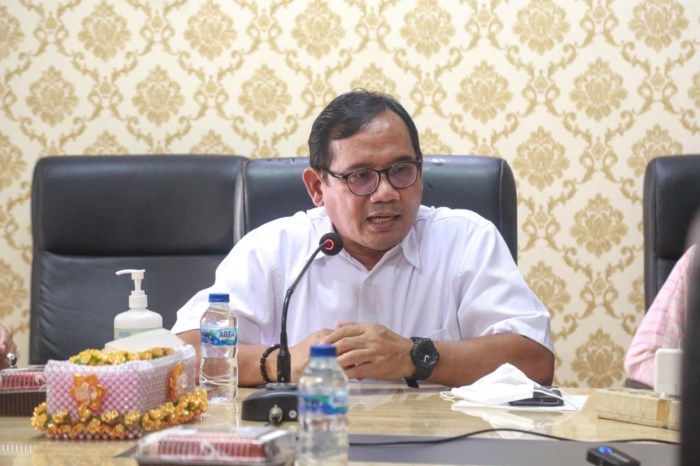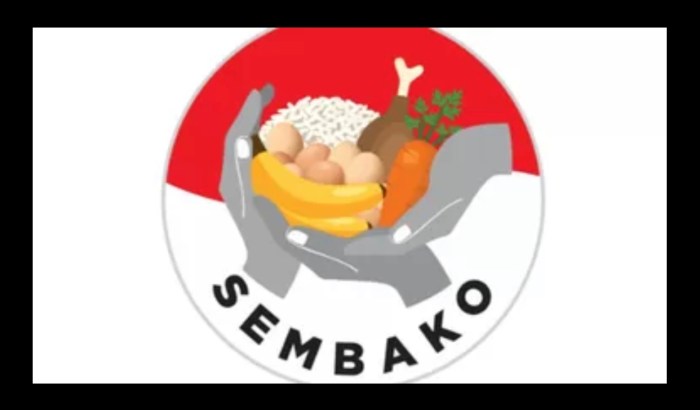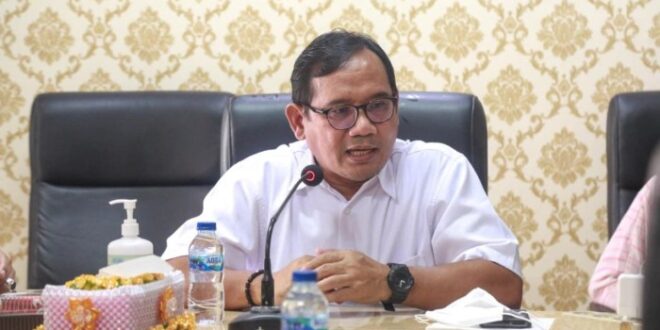Cara Mendaftar dan Memperbarui Data BPNT 2025
Info Bantuan BPNT 2025 – Program BPNT (Bantuan Pangan Non Tunai) 2025 akan kembali disalurkan kepada masyarakat yang berhak. Pendaftaran dan pembaruan data merupakan langkah krusial untuk memastikan Anda mendapatkan bantuan ini. Prosesnya dapat dilakukan secara online maupun offline, tergantung pada kebijakan daerah masing-masing dan ketersediaan infrastruktur digital. Berikut uraian lengkapnya.
Informasi mengenai BPNT 2025 masih terus diperbarui, namun bagi Anda yang membutuhkan bantuan lainnya, informasi tentang program bantuan pemerintah juga tersedia. Jika Anda mencari informasi mengenai bantuan untuk anak yatim, kunjungi halaman Cara Daftar Bantuan Anak Yatim Dari Pemerintah 2025 untuk panduan lengkapnya. Kembali ke BPNT 2025, pantau terus situs resmi pemerintah untuk mendapatkan update terbaru mengenai kriteria dan pendaftarannya.
Semoga informasi ini bermanfaat!
Langkah-Langkah Pendaftaran BPNT 2025
Proses pendaftaran BPNT 2025 melibatkan beberapa tahapan yang perlu diikuti dengan cermat. Perbedaan prosedur antara pendaftaran online dan offline perlu diperhatikan, karena masing-masing memiliki persyaratan dan mekanisme yang berbeda. Berikut langkah-langkah umum yang mungkin Anda temui.
- Kumpulkan Dokumen Persyaratan: Dokumen yang dibutuhkan umumnya termasuk Kartu Keluarga (KK), Kartu Tanda Penduduk (KTP), dan surat keterangan tidak mampu (jika diperlukan). Persyaratan ini bisa bervariasi tergantung kebijakan daerah masing-masing, sehingga sebaiknya Anda menghubungi kantor desa atau kelurahan setempat untuk informasi terkini.
- Pendaftaran Online (Jika Tersedia): Beberapa daerah mungkin menyediakan platform online untuk pendaftaran. Anda perlu mengakses situs web resmi yang ditunjuk dan mengisi formulir pendaftaran secara digital. Pastikan Anda memiliki akses internet yang stabil dan memahami prosedur yang tertera di situs web tersebut.
- Pendaftaran Offline: Pendaftaran offline umumnya dilakukan dengan mengunjungi kantor desa atau kelurahan setempat. Anda perlu menyerahkan dokumen persyaratan secara langsung kepada petugas yang berwenang. Tanyakan prosedur dan persyaratan yang berlaku di daerah Anda.
- Verifikasi Data: Setelah mendaftar, data Anda akan diverifikasi oleh petugas terkait. Proses verifikasi ini bertujuan untuk memastikan keakuratan data dan kelayakan Anda sebagai penerima BPNT.
- Pengumuman Penerima BPNT: Setelah verifikasi selesai, pengumuman penerima BPNT akan diumumkan melalui pengumuman resmi di kantor desa/kelurahan atau melalui media informasi setempat.
Langkah-Langkah Pembaruan Data BPNT
Bagi penerima BPNT yang sudah terdaftar, pembaruan data sangat penting untuk memastikan data Anda tetap akurat dan Anda terus menerima bantuan. Pembaruan data dapat dilakukan secara berkala sesuai dengan ketentuan yang berlaku.
Informasi lengkap mengenai bantuan BPNT 2025 masih terus diperbarui, pastikan Anda selalu mengecek sumber resmi. Proses verifikasi penerima bantuan seringkali melibatkan data kependudukan. Untuk memastikan data Anda akurat dan terdaftar, Anda bisa mengeceknya melalui situs Cara Cek Bantuan Ktp 2025 untuk memastikan kesesuaian data KTP Anda dengan database bantuan pemerintah. Informasi ini krusial karena akan membantu Anda dalam melacak status pengajuan BPNT 2025 dan memastikan kelancaran proses pencairan bantuan nantinya.
- Kunjungi Kantor Desa/Kelurahan: Langkah pertama adalah mengunjungi kantor desa atau kelurahan setempat untuk mendapatkan informasi mengenai prosedur pembaruan data BPNT.
- Siapkan Dokumen yang Diperlukan: Biasanya, Anda akan memerlukan KTP, KK, dan dokumen pendukung lainnya yang dibutuhkan untuk pembaruan data. Konfirmasi dokumen yang dibutuhkan kepada petugas setempat.
- Isi Formulir Pembaruan Data: Isi formulir pembaruan data dengan lengkap dan akurat. Pastikan semua informasi yang Anda berikan sesuai dengan data yang sebenarnya.
- Verifikasi Data: Petugas akan memverifikasi data yang Anda berikan. Kerjasama dengan petugas untuk mempercepat proses verifikasi.
- Konfirmasi Pembaruan Data: Setelah verifikasi selesai, konfirmasikan kepada petugas apakah pembaruan data Anda telah berhasil diproses.
Dokumen yang Dibutuhkan untuk Pendaftaran dan Pembaruan Data
Dokumen yang dibutuhkan untuk pendaftaran dan pembaruan data BPNT dapat bervariasi tergantung kebijakan daerah. Namun, beberapa dokumen umum yang sering diperlukan meliputi:
- Kartu Keluarga (KK)
- Kartu Tanda Penduduk (KTP)
- Surat Keterangan Tidak Mampu (SKTM) – (Tergantung kebijakan daerah)
- Dokumen pendukung lainnya (jika diperlukan)
Potensi Kendala dan Solusinya
Beberapa kendala mungkin dihadapi saat mendaftar atau memperbarui data BPNT. Antisipasi dan solusi yang tepat dapat memperlancar prosesnya.
Informasi mengenai BPNT 2025 masih terus diperbarui, dan penting untuk selalu memantau perkembangannya. Untuk mengetahui bantuan sosial lainnya yang mungkin tersedia, cek informasi lengkap mengenai Bantuan Bulan September 2025 yang mungkin relevan dengan kriteria penerima BPNT. Dengan memahami berbagai program bantuan yang ada, Anda dapat mengoptimalkan peluang untuk mendapatkan dukungan finansial. Kembali ke BPNT 2025, pastikan Anda memenuhi persyaratan yang berlaku agar bisa mendapatkan manfaatnya.
- Kendala: Sistem online error atau tidak dapat diakses. Solusi: Coba akses di waktu lain atau hubungi petugas terkait untuk mendapatkan bantuan.
- Kendala: Dokumen persyaratan tidak lengkap. Solusi: Lengkapilah dokumen yang dibutuhkan sebelum mendaftar atau memperbarui data.
- Kendala: Data yang dimasukkan tidak valid. Solusi: Periksa kembali data yang Anda masukkan dan pastikan semua informasi akurat.
- Kendala: Antrian panjang di kantor desa/kelurahan. Solusi: Datang lebih awal atau hubungi kantor desa/kelurahan untuk menanyakan waktu terbaik untuk datang.
Contoh Formulir Pendaftaran BPNT 2025
Berikut contoh formulir pendaftaran BPNT 2025. Perlu diingat bahwa ini hanyalah contoh dan mungkin berbeda dengan formulir yang sebenarnya digunakan di daerah Anda.
Informasi lengkap mengenai Info Bantuan BPNT 2025 masih terus diperbarui. Namun, untuk Anda yang juga membutuhkan informasi terkait bantuan pendidikan, perlu diketahui bahwa pencairan bantuan serupa juga menjadi perhatian banyak orang. Cari tahu jadwal pencairannya dengan mengunjungi artikel ini: Kapan Bantuan Kip Sma Cair 2025. Kembali ke BPNT 2025, pastikan Anda selalu memantau situs resmi untuk mendapatkan update terbaru dan informasi akurat terkait pencairan bantuan.
Informasi yang tepat akan membantu Anda dalam merencanakan keuangan.
| Kolom | Contoh Isi |
|---|---|
| Nama Kepala Keluarga | [Nama Kepala Keluarga] |
| NIK Kepala Keluarga | [NIK Kepala Keluarga] |
| Alamat | [Alamat] |
| Jumlah Anggota Keluarga | [Jumlah Anggota Keluarga] |
| Nomor Telepon | [Nomor Telepon] |
| Jenis Kelamin | [Jenis Kelamin] |
Besaran Bantuan dan Pencairan Dana BPNT 2025: Info Bantuan BPNT 2025

Program BPNT (Bantuan Pangan Non Tunai) 2025 diharapkan akan tetap menjadi pilar penting dalam upaya pemerintah untuk mengurangi angka kemiskinan dan meningkatkan gizi masyarakat kurang mampu. Perkiraan besaran bantuan dan mekanisme pencairannya menjadi hal krusial yang perlu dipahami oleh para penerima manfaat. Berikut ini uraian detail mengenai hal tersebut, dengan tetap mempertimbangkan bahwa angka-angka yang disebutkan merupakan proyeksi dan dapat berubah sesuai kebijakan pemerintah terbaru.
Besaran Bantuan BPNT 2025
Besaran bantuan BPNT 2025 diperkirakan akan mengalami penyesuaian, mengikuti perkembangan inflasi dan kebutuhan hidup masyarakat. Meskipun angka pasti belum diumumkan secara resmi, berdasarkan tren beberapa tahun terakhir, dapat diasumsikan bahwa besaran bantuan per bulan akan berada di kisaran Rp200.000 hingga Rp300.000 per Kartu Keluarga (KK). Penyesuaian ini bertujuan agar bantuan tetap relevan dan mampu memenuhi kebutuhan pangan dasar keluarga penerima manfaat.
Mekanisme Pencairan Dana BPNT 2025
Pencairan dana BPNT 2025 diperkirakan masih akan menggunakan mekanisme transfer dana non-tunai melalui rekening bank atau aplikasi e-wallet yang telah terdaftar. Prosesnya umumnya diawali dengan verifikasi data penerima manfaat oleh pihak terkait, kemudian dilanjutkan dengan penyaluran dana ke rekening atau aplikasi yang telah ditentukan. Kecepatan pencairan dana bergantung pada kelancaran proses verifikasi data dan sistem penyaluran dana dari pihak bank atau e-wallet.
Ilustrasi Skenario Pencairan Dana BPNT 2025
Berikut ilustrasi skenario pencairan dana BPNT 2025 untuk keluarga dengan jumlah anggota berbeda, dengan asumsi besaran bantuan Rp250.000 per bulan per KK:
| Jumlah Anggota Keluarga | Besaran Bantuan Per Bulan (Rp) |
|---|---|
| 2 Orang | 250.000 |
| 4 Orang | 250.000 |
| 6 Orang | 250.000 |
Perlu dicatat bahwa ilustrasi di atas merupakan contoh dan besaran bantuan yang diterima tetaplah Rp250.000 per KK, terlepas dari jumlah anggota keluarga. Kebijakan ini bertujuan untuk memastikan keadilan dan pemerataan bantuan.
Metode Pencairan Dana BPNT 2025 dan Perbandingannya
Beberapa metode pencairan dana BPNT 2025 yang mungkin digunakan meliputi transfer ke rekening bank Himbara (Himpunan Bank Negara), dan aplikasi e-wallet. Setiap metode memiliki kelebihan dan kekurangan:
- Transfer ke Rekening Bank Himbara: Kelebihannya adalah keamanan dan kemudahan akses bagi penerima manfaat yang sudah memiliki rekening bank. Kekurangannya adalah membutuhkan rekening bank aktif dan akses ke layanan perbankan.
- Aplikasi E-Wallet: Kelebihannya adalah aksesibilitas yang lebih luas, terutama bagi masyarakat yang belum memiliki rekening bank. Kekurangannya adalah potensi risiko keamanan dan ketergantungan pada jaringan internet.
Transparansi Penyaluran Dana BPNT
“Pemerintah berkomitmen untuk memastikan transparansi dan akuntabilitas dalam penyaluran dana BPNT. Mekanisme pengawasan yang ketat diterapkan untuk mencegah penyimpangan dan memastikan bantuan tepat sasaran.” – Sumber: Kementerian Sosial Republik Indonesia (Pernyataan resmi, perlu verifikasi sumber yang lebih spesifik)
Pertanyaan Umum Seputar BPNT 2025

Program BPNT (Bantuan Pangan Non Tunai) 2025 diharapkan akan tetap menjadi penopang penting bagi kesejahteraan masyarakat kurang mampu. Memahami syarat dan ketentuannya, serta prosedur penanganan masalah yang mungkin muncul, sangat krusial bagi calon dan penerima manfaat. Berikut beberapa pertanyaan umum yang sering diajukan, dirumuskan ulang menjadi informasi yang informatif dan mudah dipahami.
Syarat Penerima BPNT 2025
Syarat untuk mendapatkan BPNT 2025 pada dasarnya mengacu pada kriteria kemiskinan dan kerentanan yang ditetapkan pemerintah. Data penerima biasanya bersumber dari Data Terpadu Kesejahteraan Sosial (DTKS) Kementerian Sosial. Secara umum, persyaratan meliputi terdaftar sebagai keluarga miskin atau rentan miskin dalam DTKS, memiliki Kartu Keluarga (KK), dan Kartu Tanda Penduduk (KTP) yang masih berlaku. Proses verifikasi dan validasi data akan dilakukan secara ketat untuk memastikan penyaluran bantuan tepat sasaran.
Cara Melaporkan Kesalahan Data Penerima BPNT
Jika terdapat kesalahan data penerima BPNT, segera laporkan melalui jalur resmi yang telah ditentukan. Biasanya, laporan dapat disampaikan ke petugas di desa/kelurahan setempat, atau melalui website dan aplikasi resmi yang dikelola oleh pemerintah. Sebaiknya lampirkan bukti-bukti pendukung yang relevan, seperti fotokopi KTP, KK, dan bukti-bukti lain yang menunjukkan adanya kesalahan data. Ketepatan dan kecepatan pelaporan sangat penting untuk mempercepat proses koreksi data.
Tindakan Jika Bantuan BPNT 2025 Tidak Cair
Jika bantuan BPNT 2025 tidak cair sesuai jadwal, langkah pertama adalah mengecek status penerima melalui kanal resmi yang telah ditentukan. Kemungkinan penyebabnya beragam, mulai dari kesalahan data hingga kendala teknis. Jika setelah pengecekan masih belum jelas, segera hubungi petugas terkait di desa/kelurahan atau lembaga penyalur bantuan untuk menanyakan penyebab dan solusi yang tepat. Dokumentasikan semua komunikasi dan langkah-langkah yang telah dilakukan sebagai bukti pelacakan.
Sumber Informasi Resmi BPNT 2025
Informasi resmi dan terpercaya mengenai BPNT 2025 dapat diperoleh melalui beberapa sumber. Website resmi Kementerian Sosial, situs pemerintah daerah setempat, dan media sosial resmi pemerintah menjadi rujukan utama. Hindari informasi yang berasal dari sumber tidak resmi atau tidak terpercaya, karena dapat menimbulkan kebingungan dan bahkan kerugian. Selalu verifikasi informasi sebelum mengambil tindakan.
Sanksi Penyalahgunaan Bantuan BPNT, Info Bantuan BPNT 2025
Penyalahgunaan bantuan BPNT dapat dikenakan sanksi sesuai peraturan perundang-undangan yang berlaku. Sanksi dapat berupa pencabutan hak sebagai penerima bantuan, hingga proses hukum pidana jika terbukti melakukan tindak pidana korupsi atau penipuan. Transparansi dan akuntabilitas dalam penggunaan bantuan sangat penting untuk menjaga keberlanjutan program dan memastikan bantuan tepat sasaran.



